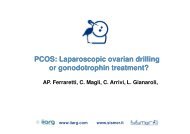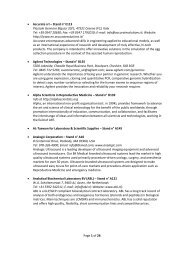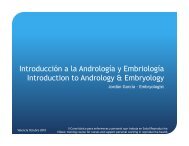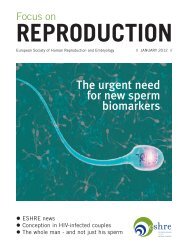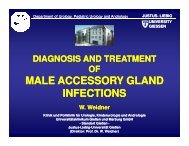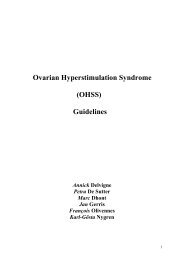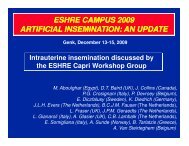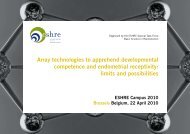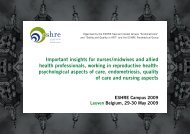The European tissue directive and intrauterine insemination - eshre
The European tissue directive and intrauterine insemination - eshre
The European tissue directive and intrauterine insemination - eshre
Create successful ePaper yourself
Turn your PDF publications into a flip-book with our unique Google optimized e-Paper software.
<strong>The</strong> <strong>European</strong> <strong>tissue</strong><br />
<strong>directive</strong>s <strong>and</strong><br />
<strong>intrauterine</strong><br />
<strong>insemination</strong><br />
Petra De Sutter<br />
ESHRE Genk<br />
Dept. Reprod. Med. Univ. Hospital Gent
Introduction: EU Tissue Directives (EUTD)<br />
• "Mother" Directive 2004/23/EC of 31/03/2004 on setting<br />
st<strong>and</strong>ards of quality <strong>and</strong> safety for the donation, procurement,<br />
testing, processing, preservation, storage <strong>and</strong> distribution of human<br />
<strong>tissue</strong>s <strong>and</strong> cells<br />
• "Technical" <strong>directive</strong> 2006/17/EC of 8/02/2006 implementing<br />
the previous one as regards certain technical requirements for the<br />
donation, procurement, <strong>and</strong> testing of human <strong>tissue</strong>s <strong>and</strong> cells<br />
• "Technical" <strong>directive</strong> 2006/86/EC of 24/10/2006 implementing<br />
the "mother" <strong>directive</strong> as regards traceability requirements,<br />
notification of serious adverses reactions <strong>and</strong> events <strong>and</strong> certain<br />
technical requirements for the coding, processing, preservation,<br />
storage <strong>and</strong> distribution of human <strong>tissue</strong>s <strong>and</strong> cells
Mother <strong>directive</strong> 2004/23/EC<br />
Accreditation, designation, authorisation or licensing of <strong>tissue</strong><br />
establishments <strong>and</strong> <strong>tissue</strong> <strong>and</strong> cell preparation processes<br />
Inspections <strong>and</strong> control measures<br />
Traceability<br />
Import/export of human <strong>tissue</strong>s <strong>and</strong> cells<br />
Register of <strong>tissue</strong> establishments <strong>and</strong> reporting obligations<br />
Notification of serious adverse events <strong>and</strong> reactions<br />
Donor selection <strong>and</strong> evaluation<br />
Quality management, responsible persons, personnel<br />
Tissue <strong>and</strong> cell reception, processing, storage conditions<br />
Labelling, documentation <strong>and</strong> packaging, distribution<br />
Relations between <strong>tissue</strong> establishments <strong>and</strong> third parties<br />
Coding<br />
Reports<br />
Penalties
Mother <strong>directive</strong> 2004/23/EC<br />
(7) This Directive should apply to <strong>tissue</strong>s <strong>and</strong> cells<br />
including haematopoietic peripheral blood, umbilical-<br />
cord (blood) <strong>and</strong> bone-marrow stem cells, reproductive<br />
cells (eggs, sperm), foetal <strong>tissue</strong>s <strong>and</strong> cells <strong>and</strong> adult<br />
<strong>and</strong> embryonic stem cells.
Principles of gamete donation<br />
<br />
<strong>The</strong> majority of Member States have legislation in respect of:<br />
<br />
<br />
<br />
• Confidentiality (measures ensuring that all data collated, including<br />
genetic information, has been rendered anonymous so that the<br />
donor <strong>and</strong> the recipient are no longer identifiable);<br />
• Anonymity (measures regulating the disclosure of the identity of<br />
the donor. This could mean either that the donor must by law remain<br />
anonymous or, on the contrary, that the donor must by law forego<br />
his/her anonymity.);<br />
• Non-Remuneration for the donation (measures preventing organ<br />
trade or trafficking).
TD1: 2006/17/EC – Annex III: SELECTION CRITERIA AND LABORATORY<br />
TESTS REQUIRED FOR DONORS OF REPRODUCTIVE CELLS AS REFERRED<br />
TO IN ARTICLE 3(b) AND ARTICLE 4(2)<br />
1. Partner donation for direct use: Donor<br />
selection criteria <strong>and</strong> laboratory testing do not<br />
need to be applied in the case of partner<br />
donation of reproductive cells for direct use.<br />
2. Partner donation (not direct use):<br />
Reproductive cells that are processed <strong>and</strong>/or<br />
stored <strong>and</strong> reproductive cells that will result in the<br />
cryopreservation of embryos must meet the<br />
following criteria:
TD1: 2006/17/EC – Annex III: SELECTION CRITERIA AND LABORATORY<br />
TESTS REQUIRED FOR DONORS OF REPRODUCTIVE CELLS AS REFERRED<br />
TO IN ARTICLE 3(b) AND ARTICLE 4(2)<br />
2.1. the clinician responsible for the donor must determine<br />
<strong>and</strong> document, based on the patient’s medical history <strong>and</strong><br />
therapeutic indications, the justification for the donation<br />
<strong>and</strong> its safety for the recipient <strong>and</strong> any child(ren) that<br />
might result;<br />
2.2. the following biological tests must be carried out to<br />
assess the risk of cross-contamination: HIV 1 <strong>and</strong> 2 (Anti-<br />
HIV-1,2); Hepatitis B (HBsAg; Anti-HBc); Hepatitis C (Anti-<br />
HCV-Ab). In case of sperm processed for <strong>intrauterine</strong><br />
<strong>insemination</strong> <strong>and</strong> not to be stored, if the <strong>tissue</strong><br />
establishment can demonstrate that the risk of cross<br />
contamination <strong>and</strong> staff exposure has been addressed<br />
through the use of validated processes, biological testing<br />
may not be required;
TD1: 2006/17/EC – Annex III: SELECTION CRITERIA AND LABORATORY<br />
TESTS REQUIRED FOR DONORS OF REPRODUCTIVE CELLS AS REFERRED<br />
TO IN ARTICLE 3(b) AND ARTICLE 4(2)<br />
2.3. where HIV 1 <strong>and</strong> 2, hepatitis B or hepatitis C test results are<br />
positive or unavailable, or where the donor is known to be a source<br />
of infection risk, a system of separate storage must be devised;<br />
2.4. HTLV-I antibody testing must be performed for donors living in<br />
or originating from high-incidence areas or with sexual partners<br />
originating from those areas or where the donor’s parents originate<br />
from those areas;<br />
2.5. in certain circumstances, additional testing may be required<br />
depending on the donor’s travel <strong>and</strong> exposure history <strong>and</strong> the<br />
characteristics of the <strong>tissue</strong> or cells donated (e.g. Rh D, malaria,<br />
CMV, T. cruzi);<br />
2.6. positive results will not necessarily prevent partner donation in<br />
accordance with national rules.
TD1: 2006/17/EC – Annex III: SELECTION CRITERIA AND LABORATORY<br />
TESTS REQUIRED FOR DONORS OF REPRODUCTIVE CELLS AS REFERRED<br />
TO IN ARTICLE 3(b) AND ARTICLE 4(2)<br />
3. Donations other than by partners: <strong>The</strong> use of reproductive cells other than<br />
for partner donation must meet the following criteria:<br />
3.1. donors must be selected on the basis of their age, health <strong>and</strong> medical<br />
history, provided on a questionnaire <strong>and</strong> through a personal interview performed<br />
by a qualified <strong>and</strong> trained healthcare professional. This assessment must include<br />
relevant factors that may assist in identifying <strong>and</strong> screening out persons whose<br />
donation could present a health risk to others, such as the possibility of<br />
transmitting diseases (such as sexually transmitted infections), or health risks to<br />
themselves (e.g. superovulation, sedation or the risks associated with the egg<br />
collection procedure or the psychological consequences of being a donor);<br />
3.2. the donors must be negative for HIV 1 <strong>and</strong> 2, HCV, HBV <strong>and</strong> syphilis on a<br />
serum or plasma sample, tested in accordance with Annex II, point 1.1, <strong>and</strong><br />
sperm donors must additionally be negative for chlamydia on a urine sample<br />
tested by the nucleic acid amplification technique (NAT);
TD1: 2006/17/EC – Annex III: SELECTION CRITERIA AND LABORATORY<br />
TESTS REQUIRED FOR DONORS OF REPRODUCTIVE CELLS AS REFERRED<br />
TO IN ARTICLE 3(b) AND ARTICLE 4(2)<br />
3.3. HTLV-I antibody testing must be performed for donors living in or originating<br />
from high-incidence areas or with sexual partners originating from those areas or<br />
where the donor’s parents originate from those areas;<br />
3.4. in certain circumstances, additional testing may be required depending on<br />
the donor’s history <strong>and</strong> the characteristics of the <strong>tissue</strong> or cells donated (e.g. RhD,<br />
malaria, CMV, T. cruzi).<br />
3.5. for autologous donors, Annex I, point 2.1.1 applies;<br />
3.6. genetic screening for autosomal recessive genes known to be prevalent,<br />
according to international scientific evidence, in the donor’s ethnic background<br />
<strong>and</strong> an assessment of the risk of transmission of inherited conditions known to be<br />
present in the family must be carried out, after consent is obtained. Complete<br />
information must be provided, in accordance with the requirements in force in<br />
Member States. Complete information on the associated risk <strong>and</strong> on the measures<br />
undertaken for its mitigation must be communicated <strong>and</strong> clearly explained to the<br />
recipient.
TD1: 2006/17/EC – Annex III: SELECTION CRITERIA AND LABORATORY<br />
TESTS REQUIRED FOR DONORS OF REPRODUCTIVE CELLS AS REFERRED<br />
TO IN ARTICLE 3(b) AND ARTICLE 4(2)<br />
Sperm donations other than by partners will be quarantined for a minimum of<br />
180 days, after which repeat testing is required. If the blood donation sample is<br />
additionally tested by the nucleic acid amplification technique (NAT) for HIV, HBV<br />
<strong>and</strong> HCV, testing of a repeat blood sample is not required. Retesting is also not<br />
required if the processing includes an inactivation step that has been validated<br />
for the viruses concerned.<br />
Annex IV: <strong>The</strong> organisation performing the procurement must produce a<br />
procurement report, which is passed on to the <strong>tissue</strong> establishment. Where sperm<br />
is procured at home, the procurement report must state this <strong>and</strong> must contain only:<br />
(a) the name <strong>and</strong> address of the <strong>tissue</strong> establishment to receive the cells/<strong>tissue</strong>s;<br />
(b) the donor identification.<br />
<strong>The</strong> date <strong>and</strong> time of procurement may be included, where possible.
Serology : Lab requirements<br />
Separate storage of samples necessary:<br />
when positive tests<br />
when results unknown at moment of storage<br />
Systems for separate storage:<br />
High security straws<br />
Separate storage tanks
TD2: 2006/86/EC<br />
Quality Management System: ISO 9001/15189<br />
Air quality conditions: A in D except when air quality<br />
requirements have detrimental effect on <strong>tissue</strong>s or cells,<br />
there is a low additional risk of transmitting infection upon<br />
application to the human body, technical incompatibility<br />
(However; the air quality always needs to be documented)<br />
Traceability: of everything !<br />
Coding: EU code only for non-partner donation<br />
Notification of adverse reactions <strong>and</strong> events
http://www.<strong>eshre</strong>.com/binarydata.aspx?type=doc/<br />
ESHRE_position_paper_on_the_EU_Tissues_<strong>and</strong>_Cells_Directive_EC_final.pdf
ESHRE position paper<br />
<br />
In an ART perspective the EUTD involves basically minimizing the<br />
risk of two severe adverse events, namely transmission of<br />
infections <strong>and</strong> prevention of gamete/zygote/embryo exchange<br />
(mix-up). <strong>The</strong> <strong>directive</strong> is not concerned with pointing at specific<br />
ways of increasing "performance" such as success rates. Instead,<br />
the <strong>directive</strong> aims at increasing quality through m<strong>and</strong>atory<br />
implementation of a quality management system. This involves<br />
the presence of adequately trained <strong>and</strong> certified staff, full<br />
documentation <strong>and</strong> formulation of st<strong>and</strong>ard operating<br />
procedures, quality control <strong>and</strong> quality assurance at all units<br />
performing assisted reproduction.
ESHRE position paper<br />
<br />
<br />
<strong>The</strong> EUTD will have a profound impact on all units conducting<br />
assisted reproduction. All units will have to be licensed or<br />
accredited as decided by the national authorities. Further, all units<br />
must implement a quality management system with written<br />
st<strong>and</strong>ard operating procedures <strong>and</strong> ensure full documentation of<br />
all activities in the clinic/unit - including full traceability for all<br />
materials used in each treatment. This documentation must be kept<br />
for 30 years.<br />
“Donor” means every human source, whether living or deceased,<br />
of human cells <strong>and</strong> <strong>tissue</strong>s. Partner donation means the donation of<br />
reproductive cells between a man <strong>and</strong> a woman who declare to<br />
have an intimate physical relationship. In a couple, man <strong>and</strong><br />
woman are considered donors to each other.
ESHRE position paper<br />
<br />
<br />
<br />
<br />
Cells <strong>and</strong> <strong>tissue</strong>s have to be traceable from donor to acceptor <strong>and</strong><br />
vice versa. Traceability is also m<strong>and</strong>atory to all products <strong>and</strong><br />
materials coming into contact with <strong>tissue</strong>s <strong>and</strong> cells. This includes<br />
for instance all culture media, all culture media supplements <strong>and</strong><br />
all disposables,<br />
A unique <strong>European</strong> coding system is not applicable to<br />
reproductive <strong>tissue</strong>s <strong>and</strong> cells for partner donation. A unique code<br />
guaranteeing traceability remains however required.<br />
<strong>The</strong> EU has ordered a workshop at CEN, the <strong>European</strong> Committee<br />
of St<strong>and</strong>ardization, to propose a unique <strong>European</strong> coding system<br />
which will apply in case of non -partner donation.<br />
In assisted reproduction every misidentification or mix-up of<br />
gametes, zygotes or embryos is to be considered a serious<br />
adverse event.
ESHRE position paper: problems<br />
<br />
<br />
<br />
Frequency of screening for HIV <strong>and</strong> Hepatitis: (Commission Directive<br />
2006/17/EC, Annex III.4.2.): It is specified in the <strong>directive</strong> that all donors<br />
(patients) shall be tested for HIV <strong>and</strong> Hepatitis B <strong>and</strong> C at the “time of<br />
donation”. It is however not specified if it is required to re-test the patient prior<br />
to each treatment or whether a specified interval will be acceptable. This will<br />
have a profound impact on the financial consequences of the <strong>directive</strong>. “<br />
Member states shall ensure that <strong>tissue</strong> establishments have agreements <strong>and</strong><br />
procedures in place to ensure that, in the event of termination of activities for<br />
whatever reason, stored <strong>tissue</strong>s <strong>and</strong> cells shall be transferred, according to the<br />
consent pertaining to them, to other <strong>tissue</strong> establishment or establishments<br />
accredited, designated, authorized or licensed…” This paragraph specifies<br />
what is to be done if a clinic/unit closes. ESHRE considers this the responsibility<br />
of the local authorities.<br />
Intra uterine <strong>insemination</strong>: IUI is included in the <strong>directive</strong> as it involves<br />
processing of gametes <strong>and</strong> this may have a profound impact on <strong>insemination</strong><br />
performed outside of regular fertility clinics/units.
• Staffing <strong>and</strong> direction<br />
• Policies <strong>and</strong> procedures<br />
• Laboratory safety (design, equipment, Infectious agents, Protective measures)<br />
• Identification of patients <strong>and</strong> their gametes, zygotes <strong>and</strong> embryos<br />
• Culture media preparation <strong>and</strong> quality control testing<br />
• H<strong>and</strong>ling of embryos, zygotes, oocytes <strong>and</strong> spermatozoa<br />
• Oocyte retrieval<br />
• Sperm preparation<br />
• Insemination of oocytes<br />
• Scoring for fertilization<br />
• Embryo culture adn transfer<br />
• Cryopreservation of gametes, zygotes <strong>and</strong> embryos<br />
• Assisted hatching<br />
• Preimplantation genetic diagnosis<br />
• Quality control <strong>and</strong> quality assurance
<strong>European</strong> Assisted Conception Consortium<br />
Representatives from all member states:<br />
Clinicians, embryologists, regulators<br />
Communicates with ESHRE, <strong>European</strong> Commission,<br />
HFEA
Thank you for your attention !




